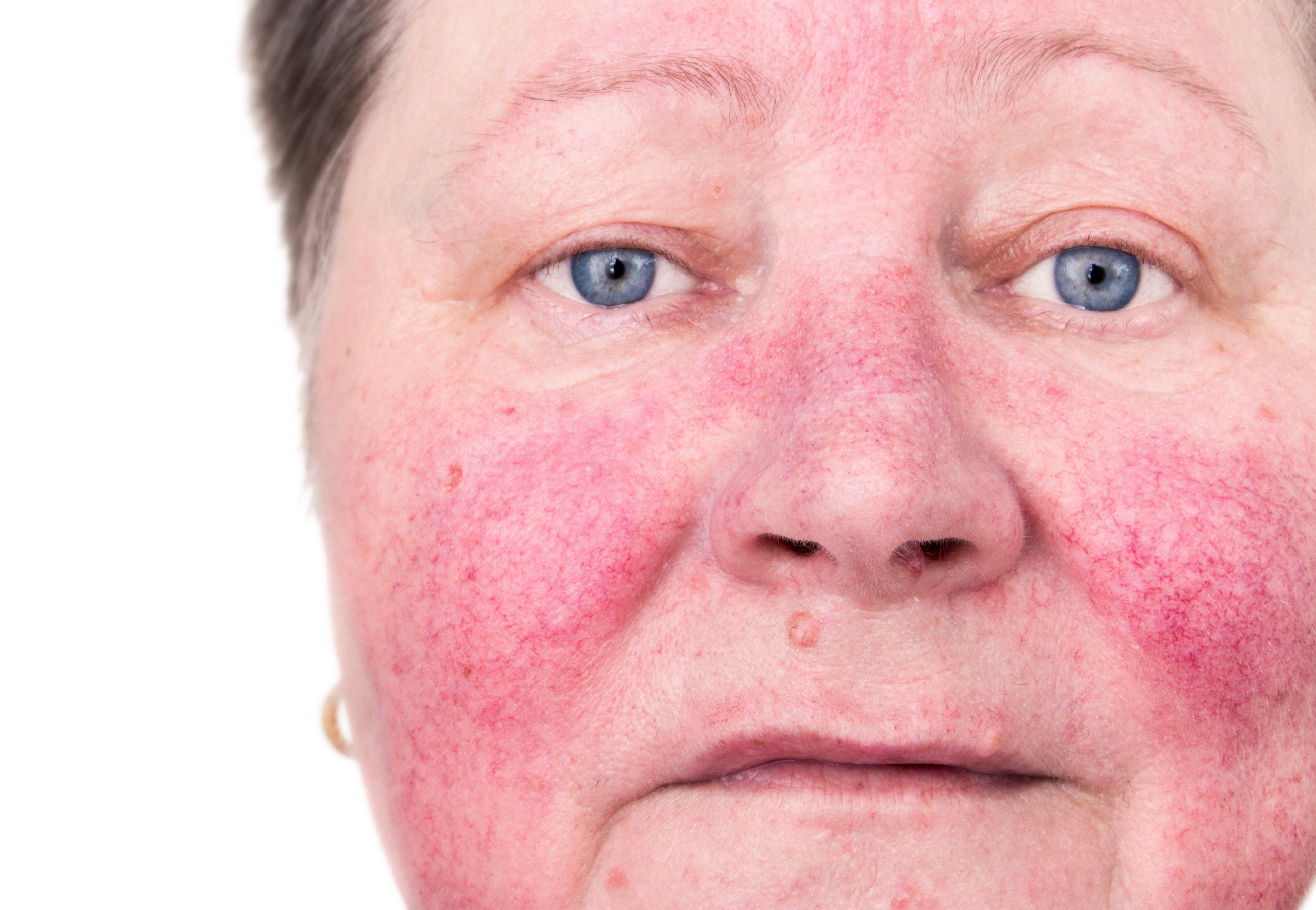- Case-Based Roundtable
- General Dermatology
- Eczema
- Chronic Hand Eczema
- Alopecia
- Aesthetics
- Vitiligo
- COVID-19
- Actinic Keratosis
- Precision Medicine and Biologics
- Rare Disease
- Wound Care
- Rosacea
- Psoriasis
- Psoriatic Arthritis
- Atopic Dermatitis
- Melasma
- NP and PA
- Skin Cancer
- Hidradenitis Suppurativa
- Drug Watch
- Pigmentary Disorders
- Acne
- Pediatric Dermatology
- Practice Management
- Prurigo Nodularis
- Buy-and-Bill
Publication
Article
Dermatology Times
New rosacea therapies show promise
Author(s):
Novel treatments for rosacea such as intradermal botulinum toxin-A and light therapies show promise, but more data is needed to prove their efficacy and safety in this patient population, says a recent paper.
Effectively managing rosacea, which presents as erythema, papules, pustules, telangiectasias, fibrosis and phyma, is important for not only a patient’s quality of life but also to avoid complications of blepharitis or conjunctivitis. (Milan Lipowski - stock.adobe.com)

Topicals, intradermal botulinum toxin-A, and laser and light therapies are among today’s newer rosacea treatment options. But many of these lack the data needed to prove they’re effective and safe for the indication, researchers report in a therapeutic hotline paper published July 11, 2019 in Dermatologic Therapy.1
Effectively managing rosacea, which presents as erythema, papules, pustules, telangiectasias, fibrosis and phyma, is important for not only a patient’s quality of life but also to avoid complications of blepharitis or conjunctivitis, according to the paper.
Dermatologists often use topicals and systemic agents to treat and manage chronic papulopustular rosacea and periorificial dermatitis.
RELATED: Research links rosacea with inflammatory diseases
Among today’s newer options:
LASER AND LIGHT THERAPIES
Laser and light devices target vascular manifestations of rosacea. For example, to treat erythematotelangiectatic rosacea, providers might use a pulsed dye laser or intense pulse light, according to Dermatology Therapy.
We prefer alaser treatment option at our center, says author of the Dermatology Therapy paper Professor Recep Dursun, M.D., of the department of dermatology and venereal diseases at Necmettin Erbakan University, in Konya, Turkey.
“We have the Quadrostar PRO Yellow 577 nm laser device for the treatment of vascular lesions and capillary abnormalities. The erythematotelangiectatic rosacea and papulopustular rosacea patients who suffer from flushing, redness and appearance of telangiectasias usually leave satisfied [with the treatment],” he says.
Lasers and light therapies are popular advances in rosacea treatment around the world, according to Dr. Dursun. They allow dermatologists to offer an aesthetically pleasing and quick option for patients, he says.
TOPICAL IVERMECTIN 1% CREAM
Approved by the U.S. Food and Drug Administration (FDA) in 2014 for the treatment of rosacea, topical ivermectin 1% cream targets Demodex folliculorum and Demodex brevis, according to the paper.
Researchers reported in 2014 in the Journal of Drugs in Dermatology that Ivermectin 1% cream effectively and safely treats inflammatory lesions of papulopustular rosacea.2
RELATED: Effective OTC adjunct therapy
Researchers report in an update in rosacea management published June 2019 in the Journal of Clinical and Aesthetic Dermatology on a meta-analysis of 19 clinical trials that show ivermectin 1% cream once daily seems more effective than and at least as tolerable and safe as other available topical agents used to treat papulopustular rosacea.3
However, there are no true head-to-head comparative studies except for studies comparing ivermectin 1% cream to metronidazole 0.75% cream, according to the Journal of Clinical and Aesthetic Dermatology.
TOPICALS BRIMONIDINE AND OXYMETAZOLINE
The FDA approved brimonidine 0.33% gel to treat rosacea in 2013. It relieves rosacea symptoms by targeting vasomotor dysregulation in rosacea pathogenesis, according to the paper in Dermatologic Therapy.
Published guidelines recommend use of topical brimonidine, along with topical ivermectin, for the treatment of papulopustular rosacea with diffuse persistent facial erythema of at least moderate severity. Topical brimonidine also is recommended in combination with the potassium titanyl phosphate laser to address diffuse persistent facial erythema associated with rosacea, according to authors of the update in the Journal of Clinical and Aesthetic Dermatology.
Oxymetazoline is a topical α-1 agonist. It was approved by the FDA to treat persistent facial erythema in adult rosacea. Dermatologists should consider using oxymetazoline 1% cream to manage persistent, nontransient, facial erythema associated with adult rosacea. The cream has also been shown to reduce persistent facial erythema when used concurrently with agents that reduce papulopustular lesions and perilesional erythema in papulopustular rosacea patients, according to the Journal of Clinical and Aesthetic Dermatology.
INTRADERMAL BOTULINUM TOXIN-A
“Neurogenic vascular dysfunction can be a crucial pathogenic step in rosacea,” according to the authors of the paper in Dermatologic Therapy. Botulinum toxin-A blocks presynaptic acetylcholine release and acetylcholine is thought to be effective for vasodilation on the skin, they write.
Intradermal botulinum toxin injections significantly reduced erythema and rejuvenated skin on the facial cheeks of rosacea patients, according to a small study published earlier this year in Dermatologic Surgery.4
While promising, more research is needed to confirm the efficacy and safety of these newer therapies for rosacea treatment, including intradermal botulinum toxin-A, authors of the Dermatologic Therapy paper conclude. Â
Disclosures:
Dr. Dorsun reports no relevant conflicts.
References:
1. Dursun R, Daye M, Durmaz K. Acne and rosacea: What’s new for treatment?. Dermatol Ther. 2019;:e13020.
2. Stein L, Kircik L, Fowler J, et al. Efficacy and safety of ivermectin 1% cream in treatment of papulopustular rosacea: results of two randomized, double-blind, vehicle-controlled pivotal studies. J Drugs Dermatol. 2014;13(3):316-23.
3. Del rosso JQ, Tanghetti E, et al. Update on the Management of Rosacea from the American Acne & Rosacea Society (AARS). J Clin Aesthet Dermatol. 2019;12(6):17-24.
4. Kim MJ, Kim JH, Cheon HI, et al. Assessment of Skin Physiology Change and Safety After Intradermal Injections With Botulinum Toxin: A Randomized, Double-Blind, Placebo-Controlled, Split-Face Pilot Study in Rosacea Patients With Facial Erythema. Dermatol Surg. 2019.







